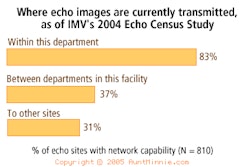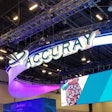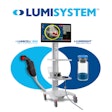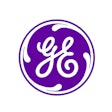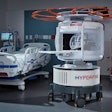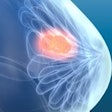CHICAGO - New ultrasound and x-ray systems are being touted in the RSNA booth of Toshiba America Medical Systems, and the Tustin, CA, company is also promoting advances to its MRI and CT product lines.
Ultrasound
The RSNA meeting marked the first RSNA appearances for a pair of new ultrasound scanners Toshiba introduced during 2005: Xario, a premium scanner that stands one tier below the company's super-premium Aplio scanner, and Famio, a grayscale unit designed for physician offices. Toshiba also introduced a new second-generation version of its tissue harmonics package for its super-premium Aplio system.
Expanded differential tissue harmonic imaging (DTHI) is the latest addition to the company's Aplio XV premium package. The upgrade offers improvements in image resolution as well as improved efficiency, and in particular allows users to scan heavier patients due to its better tissue penetration, according to Gordon Parhar, director of Toshiba's ultrasound business unit.
For the Xario scanner, Toshiba is highlighting 4D imaging technology, which Toshiba believes will increase exam success rates by using automated 4D volume acquisition with the touch of a button, and by simultaneously displaying 2D and continuously updated 4D images. Other new 4D features on Xario include postprocessing tools, real-time MPR display, and a 4D calculation package.
Toshiba also is demonstrating Encompass, a standalone workstation for offline analysis of 3D ultrasound data. The workstation was developed through a partnership between Toshiba and cardiac image management firm Heartlab (now part of Agfa HealthCare of Greenville, SC).
X-ray
Toshiba has been adding flat-panel digital technology to its x-ray and vascular imaging systems at a rapid clip, and at this week's meeting is demonstrating the fruits of its labors. The company is showing three new systems it's introduced since last year's RSNA meeting, according to Don Volz, director of Toshiba's x-ray business unit.
For the Infinix VC-i cardiovascular imaging system, Toshiba has introduced a digital detector with a larger field-of-view, a 12 x 16-inch amorphous silicon flat-panel detector supplied by Varian Medical Systems of Palo Alto, CA. Infinix VC-i includes 3D angiography capabilities, a zoom fluoroscopy mode, and C-arm motion capable of lateral coverage. The unit was cleared by the FDA in October, and Toshiba expects to have 20 units installed by March 2006. Older Infinix VC-i systems in the field can upgrade to the version with the larger field-of-view, according to the company.
The Kalare radiography/fluoroscopy system, first introduced at the 2004 RSNA show, has received a flat-panel digital upgrade as well. Toshiba is demonstrating the system with a 14 x 17-inch DR panel -- the detector can either be used as part of a wall stand or can be inserted into the table bucky. The configuration enables facilities to convert their x-ray operations to filmless without adding a second radiography room, Volz said.
Toshiba's T.Rad Plus Digital radiography system has received a new pivoting room configuration also designed to save money for facilities converting their x-ray to digital. The system's Pivot table has a rotating base that allows users to move it into the desired position when imaging patients. A removable 14 x 17-inch detector from Canon Medical Systems of Irvine, CA, enables users to conduct either chest or table studies, and the detector can be used in either portrait or landscape configurations.
CT
In CT, Toshiba is talking up advanced applications for its Aquilion 64 multislice CT scanner. Toshiba has added adaptive ECG modulation to its SureCardio heart imaging package, enabling users to better select the best window of the cardiac cycle for studies. Toshiba believes the change should result in a 50% drop in patient radiation dose, according to Doug Ryan, director of Toshiba's CT business unit. The change also better enables Aquilion 64 users to handle patients with varying heart rates.
Toshiba has also made improvements to its SureStart coronary CTA package, enabling users to better determine the time of best contrast enhancement in the heart to avoid washout.
Improving clinical workflow is also a theme for Toshiba's CT business at the meeting, with the company showing a 28-images-per-second reconstruction speed as a work-in-progress for its SureWorkflow package, and enhanced DICOM data transfer between 32- and 64-slice Aquilion scanners to 3D workstation from Toshiba's partner Vital Images of Minnetonka, MN.
Toshiba is also expanding its marketing activities for its Aquilion LB large-bore scanner beyond radiation oncology to include bariatric and interventional radiology market segments. Aquilion LB began shipping in September, Ryan said.
Toshiba is also discussing its ongoing efforts to develop a 256-slice CT scanner. The system would use Toshiba's Quantum detectors, with a matrix of 256 x 0.5-mm slices and 125 cm of organ coverage per rotation. A prototype model is in operation in Japan, and several papers on the technology are being presented this week during the RSNA show, including one on human subjects. Toshiba estimates that a 256-slice scanner is two years from market, Ryan said.
Finally, Toshiba is touting its educational initiatives in CT, such as its participation in the Core64 study comparing cardiac CTA to conventional coronary catheterization, and a new study examining the use of low-dose CT in lung imaging.
MRI
New in the MRI section of Toshiba's booth is a new ZGV upgrade for the company's Vantage 1.5-tesla MRI scanner. Vantage ZGV's gradients are rated at 33 mT/m rise time and a 200 mT/m/sec slew rate, compared with a 30 mT/m rise time and 130 mT/m/sec for Vantage XGV, until recently the most powerful scanner in the Vantage product line.
Vantage ZGV also includes what Toshiba calls the Mach 8 processor, a new CPU that allows reconstruction rates of 1,230 images per second. Vantage ZGV is being shown as a work-in-progress, with the first unit undergoing clinical evaluation at Steinberg Diagnostic Medical Imaging in Las Vegas. FDA clearance is expected by the end of the year, and owners of other Vantage scanners can upgrade to the ZGV package.
Also for Vantage scanners, Toshiba is launching two new coils, one for long bones like the humerus and femur, and the other a 32-channel head/spine coil. Both are being shown as works-in-progress.
On the applications side, Toshiba is announcing new techniques for Vantage. One is JET, which uses software to correct for patient motion, resulting in sharper, more refined images, according to the company. Toshiba believes the technique, being shown as a work-in-progress, will eliminate the need for repeat MRI scans.
The other application, dual uniform overlay (DUO), allows clinicians to use two of the company's SPEEDER parallel imaging coils simultaneously, resulting in high-resolution images over a larger field-of-view. Users can image the entire torso in one process, improving efficiency.
Finally, Vantage FZ is a new software release for Vantage that concentrates on throughput enhancements and sequences.
By Brian Casey
AuntMinnie.com staff writer
November 28, 2005
Copyright © 2005 AuntMinnie.com





